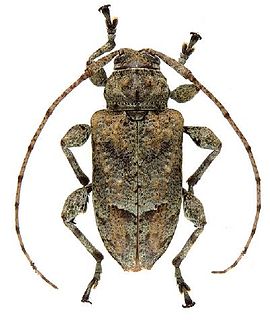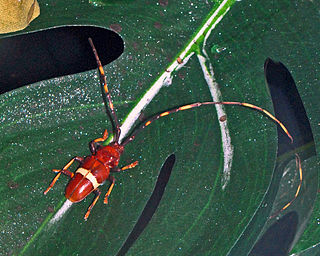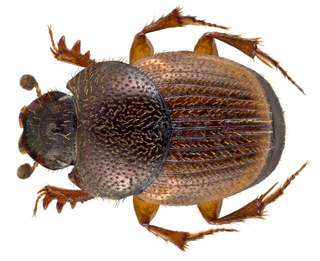
Myrmicaria brunnea is a species of ant that is native to southern Asia. They have a distinctive down-curved abdomen and spines on the thorax.

Leptostylopsis annulipes is a species of longhorn beetles of the subfamily Lamiinae.
Zosteromeigenia mima is a species of fly in the family Tachinidae and the sole representative of the genus Zosteromeigenia. Like the vast majority of tachinid flies, Z. mima is expected to be a parasitoid of other arthropods, likely the larvae of Lepidoptera, however few or no host records exist.

Orthomegas cinnamomeus is a species of beetle in the genus Orthomegas of the family Cerambycidae. It was described by Carl Linnaeus in his landmark 1758 10th edition of Systema Naturae. It is found in Hispaniola, Trinidad, Colombia, Venezuela, the Guianas, Brazil, Ecuador, Peru and Bolivia.

Archodontes is a genus of root-boring beetles in the family Cerambycidae. It is monotypic, being represented by the single species Archodontes melanopus. It is endemic to Central America and the south-eastern United States, and bores the roots of oaks and other hardwoods.

Trachyderes succinctus is a species of beetle in the family Cerambycidae. It was described by Carl Linnaeus in his landmark 1758 10th edition of Systema Naturae.

Elaphidion irroratum is a species of beetle in the family Cerambycidae. It was described by Carl Linnaeus in his 1767 12th edition of Systema Naturae.

Eupholus azureus is a species of beetles belonging to the family Curculionidae.

Chalcophora virginiensis, the sculptured pine borer, is a metallic woodboring beetle of the Buprestidae family. It is endemic to forested areas in the eastern United States and Canada. Some authors have synonymised it with the western species Chalcophora angulicollis, but Maier and Ivie (2013) demonstrate that the species are distinct.

Galerita americana is a species of beetles in the family Carabidae. It is native to Central and South America.

Brachyopa flavescens , The Yellow Sapeater, is a fairly common, species of syrphid fly. It has been observed in Northeastern North America. Hoverflies get their names from the ability to remain nearly motionless while in flight The adults, also known as flower flies for they are commonly found around and on flowers from which they get both enegy-giving nectar and protein rich pollen. Larvae for this genus are of the rat-tailed type. B.flavescens larvae have not been described.
Acronymolpus is a genus of leaf beetles in the subfamily Eumolpinae. It is endemic to New Caledonia. There are two species placed in the genus, both of which are sexually dimorphic; the females are large and reddish, and the males are small and black. A member of the tribe Eumolpini, Acronymolpus is distinguished from other members of the tribe in New Caledonia by its enlarged metacoxae, which occupy most of the first abdominal ventrite and nearly reach its posterior margin.
Adoretus bicaudatus, is a species of shining leaf chafer found in India and Sri Lanka.

Onthophagus centricornis is a species of dung beetle found in India, Sri Lanka and Afghanistan. It is a small arboreal dung beetle inhabited in both dry and wet forests.
Hyperstoma is a genus of firefly beetles in the family Lampyridae. Previously considered as a monotypic genus, the second species of the genus was described from 2011. The genus is endemic to Sri Lanka.
Trypeticus (Trypeticus) bombacis, is a species of clown beetle found in many Oriental countries including India.
Crioceris hampsoni, is a species of leaf beetle found in India, and Sri Lanka.
Eutassa fuscicollis is a beetle in the Curculionidae family. It was first described by Thomas Broun in 1909, and is endemic to New Zealand

Brachyopa diversa , the Pale-striped Sapeater, is a rare species of syrphid fly. It has been observed in the northeastern part of North America. Hoverflies get their names from the ability to remain nearly motionless while in flight. The adults are also known as flower flies for they are commonly found around and on flowers from which they get both enegy-giving nectar and protein rich pollen. Larvae for this genus are of the rat-tailed type. B.diversa larvae have not been described.

Sphiximorpha willistoni, or Williston's wasp fly, is a rare species of syrphid fly found in eastern North America. It is a strong wasp mimic. Hoverflies can remain nearly motionless in flight. The adults are also known as flower flies for they are commonly found on flowers from which they get both enegy-giving nectar and protein rich pollen. Larvae in this genus are found in sap runs of trees.













